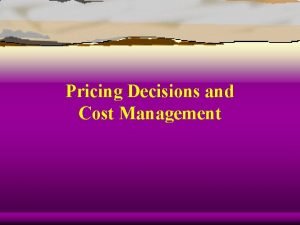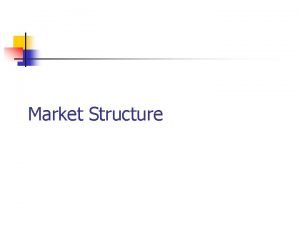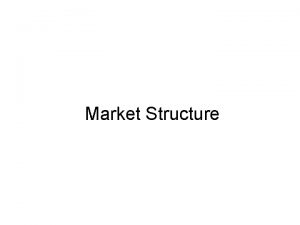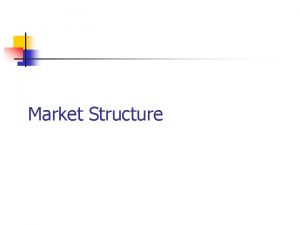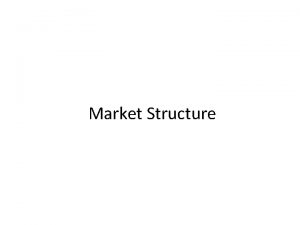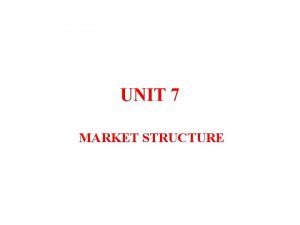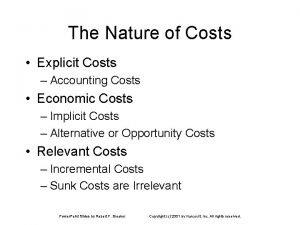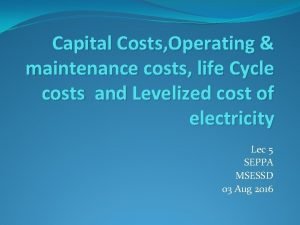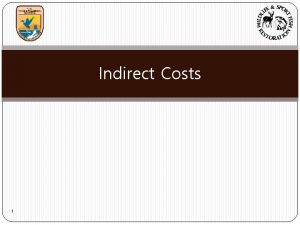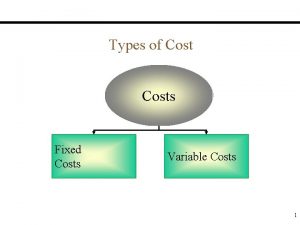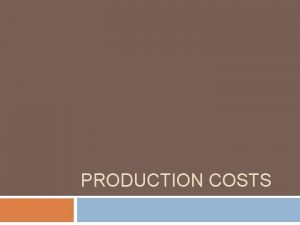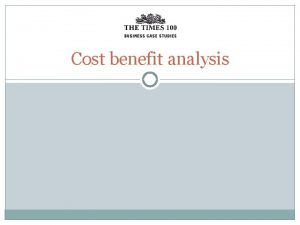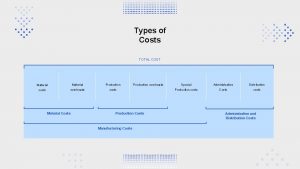Costs and market structure Cost functions and market




















- Slides: 20

Costs and market structure Cost functions and market structure Single product and multiple product firms Network externalities The role of the government

Reminder The firm’s technology: input and output • We start by introducing the production function f(x 1, …, xn) which describes the firm’s technology. • An input (or factor of production) [xi] is a good or service used to produce output. • Inputs include labour, machinery, buildings, raw materials, and energy. • The production function summarizes technically efficient ways to combine inputs to produce output. 2

Reminder A production function with two factors of production • The production function (q = f(x 1, x 2, …)) shows how many goods or services a firm can produce – the maximum output possible from a given set of inputs. q In our example: K – Capital [ das Kapital (German)] L – Labour q – Quantity produced by the firm isoquants K L The time horizon: Long run – the firm is free to choose the quantity of all factors of production Short run – at least one of these factors is fixed 3

Technology and costs • The production function: Inputs (X) Outputs (Y) • The model considers the firm as a black box • What happens inside the firm? Incentive theory (see in Lecture 10) • The theory of transaction costs (R. Coase, 1937, 1960) – Why are firms formed? – The boundaries of the firm – Residual control rights

The cost function of the single product firm • The profit maximization and the cost minimization problem of the firm Price takers Firms with market power • The cost minimization problem: Price elasticity of demand

The average cost and marginal cost functions • C(q)/q = AC(q) = AVC(q) + AFC(q) • MC(q) = d. C(q)/dq MC(q) AC(q) c AVC(q) AFC(q) q

Returns to scale (economies of scale) Reminder • „Returns to scale”, an important attribute of a given production function (technology), refers to changes in output (quantity, q) resulting from a proportional change ( ) in all inputs: • If output increases by less than that proportional change, there are decreasing returns to scale: e. g. • If output increases by that same proportional change, there are constant returns to scale: e. g. • If output increases by more than that proportional change, there are increasing returns to scale. e. g. Increasing returns to scale mean that one (big) company can produce more efficiently than more than one (smaller) firms utilizing the same factors of production emergence of natural monopolies 7

Economies of scale • The original definition: • If factor prices are fixed, the above definition is identical with • Cost elasticity of production • Fixed costs and sunk costs

The multi-product firm • The cost function: C(q 1, q 2, …, qn) • Marginal cost functions: • The ray average cost function, RAC(q): – The position of the ray is determined by the fixed shares of the products in the product mix

RAC: an example • The total cost function of a multi-product firm is as follows: c C(0, q 2) = 30 q 2 C(λ 1 q, λ 2 q) = 12. 5 q + 15 q – 3/8 q 2 C(q 1, 0) = 25 q 1 q 2 RAC(q 1, q 2) = 27. 5– 3/8 q q λ 1/λ 2 = 1 q 1

Economies of scale • Increasing returns if d. RAC/dq < 0 • Diminishing returns if d. RAC/dq > 0 • The scale index (generalized from the single product case):

Economies of scope • Cost savings from joint production • If SC > 0: economies of scope • If SC < 0: diseconomies of scope • The relationship between economies of scale and scope: from SC > 0 it usually follows that S > 1

Economies of scope and product differentiation • Similar products • Different products • Example (2. 6): Ralph Lauren’s shirts (q 1) and cologne (q 2):

Costs and market structure • Pricing in Internet-based services – Why can you access a website or an electronic journal for free? – Entry costs are high but marginal cost is negligible • The costs’ role in determining market structure

Determinants of market structure • Economies of scale (and scope) • Market size Firm size (q) where LAC is minimal (S = 1) – Minimum efficient scale << Q: competition – Minimum efficient scale > Q: natural monopoly – High minimum efficient scale (relative to total market size) high concentration • Network externalities – The value gain of a telecommunications market with n customers if the (n + 1)th joins • The role of the government policy

Network externalities and market demand (e. g. Internet access service) 16

Network externalities and market demand II. (e. g. traditional telephone service) Stable equilibria Unstable equilibrium Intermediate (unstable) equilibrium: Some consumers expect that the network will never be large, adversely affecting their willingness to pay. High (stable) equilibrium: The majority of possible users are already connected to the network (increasing the value of the network for all users).

Costs and network externalities

Network externalities and critical mass Service providers might offer the service for free or at a discounted price in the introduction phase. Critical mass reached 19

Service diffusion in the long run Saturation Mobile voice Mobile broadband Internet of Things ? (Ariosz Ltd. / NMHH [2017]: Electronic Communication Services Usage by Households and Individuals in Hungary) 20
 Cost incurrence and locked-in costs
Cost incurrence and locked-in costs Job order costing
Job order costing Requirements for effective segmentation
Requirements for effective segmentation Leader challenger
Leader challenger Cost accumulation and cost assignment
Cost accumulation and cost assignment Cost accumulation and cost assignment
Cost accumulation and cost assignment Cost pools
Cost pools What is a period cost on the income statement
What is a period cost on the income statement Cost control and cost reduction difference
Cost control and cost reduction difference Standard cost is
Standard cost is Distinguish between average cost and marginal cost
Distinguish between average cost and marginal cost Cost control and cost reduction difference
Cost control and cost reduction difference Job wr53 at nw fab
Job wr53 at nw fab Ordering cost and carrying cost
Ordering cost and carrying cost Opportunity costs and trade offs
Opportunity costs and trade offs Cost control and cost reduction project report
Cost control and cost reduction project report Cost control and cost reduction project report
Cost control and cost reduction project report Cost behavior patterns
Cost behavior patterns Manufacturing cost vs non manufacturing cost
Manufacturing cost vs non manufacturing cost Job costing and process costing
Job costing and process costing Flotation cost in cost of equity
Flotation cost in cost of equity
